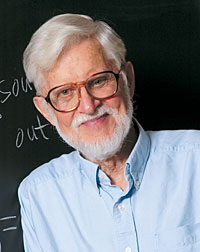Kenneth Noble Stevens
DOI: 10.1063/PT.3.2356
On the day in 1954 when Kenneth Noble Stevens was first appointed at MIT as an assistant professor, no one could have predicted the number of scientific careers he would launch, the way he would transform the thinking of his students and colleagues, or the breadth of his influence on acoustic phonetics and beyond. He was a member of the MIT faculty for more than half a century and supervised at least 50 PhD students and an untold number of master’s students, undergraduates, postdoctoral fellows, and visiting scientists. His first PhD student was James Flanagan in 1955, and his last one was Youngsook Jung in 2009.

Kenneth Noble Stevens
GREG HREN PHOTOGRAPHY/RLE AT MIT

Being in Ken’s speech communication laboratory was an extraordinary experience. The lab was full of energy and brought together researchers from many disciplines related to speech—linguistics, psychology, acoustics, computer science, physiology. That started in the 1960s, a time when multidisciplinary research was not the norm in either academia or industry. Ken was also unique for his time in that he supervised a substantial number of female graduate students. Of the first 20 women who received PhDs in electrical engineering and computer science at MIT, 4 were Ken’s students, and of the doctoral students he supervised, 23 were women.
Ken was a gentle and rigorous mentor, and he met regularly with his students and postdocs. As Haruko Kawasaki, a former postdoc of his, says, “What struck me most about Ken at these meetings was his being an exceptionally good listener.” He had a low-key manner, yet when something was not right, he would let his students know, sometimes by simply raising one eyebrow! Patti Price, another former postdoc, recalls Ken telling her, “When you measure productivity and a student is involved, you have to count both products: the progress of the research and the progress of the student.” His legendary support of students is reflected in his reluctance to put his name on their papers even though he would spend uncounted hours discussing the work and editing successive drafts.
The depth of Ken’s understanding of science formed an indelible imprint on his students and colleagues and became a model for those who pursued scientific careers; thus Ken’s influence reached far beyond any particular time and place. He was creative yet meticulous in his attention to understanding and explaining every detail of a model or of a physical mechanism. He also used words with great precision. It is no surprise, then, that his 1998 book Acoustic Phonetics (MIT Press), which became a classic overnight, took more than 20 years to complete.
Among the seminal intellectual contributions Ken made is the quantal theory of speech production, a theory that relates the underlying sound categories of language to the acoustics, physiology, and physics of the vocal tract. Another contribution is his 2002 model of speech perception based on feature cues such as landmarks. His long-term collaborations with Gunnar Fant, Morris Halle, Sheila Blumstein, Jay Keyser, and other colleagues led to important papers and lively debates on such issues as analysis-by-synthesis, invariance, distinctive features, lexical access, and feature enhancement. He also treasured his friendship and collaboration with Amar Bose, with whom he wrote a book on introductory network theory in 1965. In addition to developing theories of speech production and perception, Ken also helped create several speech-processing systems, including the KlattTalk (with Dennis Klatt) and HLsyn speech synthesizers, articulatory synthesis, automatic speech recognition (especially using acoustic landmarks), and speech-training methods for deaf children.
The Acoustical Society of America (ASA) was an important part of Ken’s career, and he believed it was the appropriate venue for promoting, discussing, and publishing all things related to speech acoustics. He served as a member of the ASA executive council in 1963–66, as vice president in 1971–72, and then as president in 1976–77. In recognition of his scientific contributions and influence, the ASA awarded Ken its Silver Medal in Speech Communication in 1983 and its Gold Medal in 1995. In 1999 President Bill Clinton awarded Ken the National Medal of Science “for his leadership and pioneering contributions to the theory of acoustics of speech production and perception, development of mathematical methods of analysis and modeling to study the acoustics of speech production, and establishing the contemporary foundations of speech science.”
Ken was devoted to his family and six children. An avid fan of the outdoors, he took great pleasure in biking, hiking, skiing, and working on his house in Maine with family and friends. He loved classical music, ice cream, and fish chowder, and was a well-tested cook of lasagna and chili.
Ken was born on 24 March 1924 in Toronto. He received his BA and MA in engineering physics from the University of Toronto in 1945 and 1948, respectively, and his ScD in electrical engineering from MIT in 1952. His dissertation was entitled “Perception of sounds shaped by resonance circuits.” His adviser was Leo Beranek. Ken died in Clackamas, Oregon, on 19 August 2013 of complications due to Alzheimer’s disease. For those of us who knew him, he will always be present in our thoughts, our work, our lives, and our teaching.
More about the Authors
Abeer Alwan. University of California, Los Angeles.
Stefanie Shattuck-Hufnagel . Massachusetts Institute of Technology, Cambridge.
Maria-Gabriella DiBenedetto. Sapienza University of Rome, Rome, Italy .
